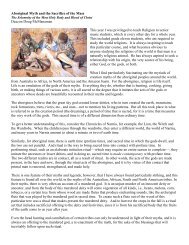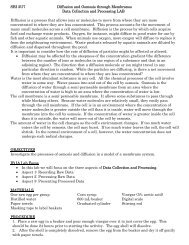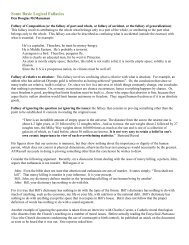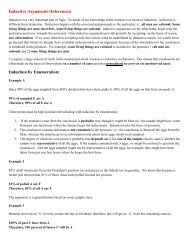"The Basic Ideas of Mircea Eliade's The Sacred and the Profane"
"The Basic Ideas of Mircea Eliade's The Sacred and the Profane"
"The Basic Ideas of Mircea Eliade's The Sacred and the Profane"
You also want an ePaper? Increase the reach of your titles
YUMPU automatically turns print PDFs into web optimized ePapers that Google loves.
during <strong>the</strong> ritual. But, as long as <strong>the</strong> participants actively are involved in <strong>the</strong> ritual event,<br />
<strong>the</strong> power <strong>of</strong> <strong>the</strong> ritual mysteriously unites all "times" into one sacred time, one chairos.<br />
If <strong>the</strong> ritual is a cosmogonic one, participants are united with <strong>the</strong> divine forces <strong>of</strong> creation<br />
so that, as <strong>the</strong> Gods are creating <strong>the</strong> world, <strong>the</strong> human participants are contemporaneous<br />
with <strong>the</strong> Gods -- <strong>and</strong> those cosmogonic events are actually taking place in <strong>the</strong>ir presence.<br />
This is a difficult notion for us, because if something is actually occurring, we cannot<br />
predict its outcome; for example, if some past Super Bowl were actually being re-played,<br />
could we be sure <strong>the</strong> final score would be <strong>the</strong> same or even that <strong>the</strong> same team would<br />
win? During a ritual enactment <strong>of</strong> <strong>the</strong> creation, however, <strong>the</strong>re really is no chance that<br />
"this time" <strong>the</strong> primeval dragon will defeat <strong>the</strong> Sky-God. <strong>The</strong>re are two reasons for this.<br />
FIrst <strong>of</strong> all, clearly <strong>the</strong> ritual has been rehearsed <strong>and</strong> will be acted out reliably. Secondly,<br />
<strong>and</strong> more importantly, it is because <strong>the</strong> ritual is not "re"presenting a past event but, in<br />
fact, is celebrating that one creative act as a present event. <strong>Eliade's</strong> point is that <strong>the</strong> people<br />
are ritually part <strong>of</strong> <strong>the</strong> original action because <strong>the</strong>y have been carried along, with all <strong>of</strong><br />
Nature, into <strong>the</strong> creative act <strong>of</strong> <strong>the</strong> cosmogony. However, <strong>the</strong> only way <strong>the</strong> cosmogony<br />
can be ritually enacted is if <strong>the</strong> people know what happened, <strong>and</strong> this is where <strong>the</strong> myth<br />
plays its great role.<br />
As noted earlier, myth is not a fairy tale or a legend, but ra<strong>the</strong>r a narrative which puts<br />
humans in contact with <strong>the</strong> deepest values <strong>of</strong> a culture <strong>and</strong> <strong>the</strong> source <strong>of</strong> those values. For<br />
religious cultures, this means that myth puts humans in contact with <strong>the</strong> Divine Reality<br />
itself.<br />
<strong>The</strong> cosmogonic myth is <strong>the</strong> paradigmatic model <strong>of</strong> <strong>the</strong> creation. It tells people what <strong>the</strong><br />
Gods did <strong>and</strong> thus enables people to become one with <strong>the</strong> Gods in <strong>the</strong> repetition <strong>of</strong> <strong>the</strong><br />
cosmogony. Although <strong>the</strong> mythic stories are well-known in a given culture, <strong>the</strong> myths are<br />
usually told on some sacred occasion. <strong>The</strong> New Year's rite is perhaps <strong>the</strong> most obvious,<br />
but Eliade has many examples <strong>of</strong> lesser occasions. Among some Pacific tribes engaged in<br />
fishing, <strong>the</strong>re is a myth recounting how <strong>the</strong> God <strong>of</strong> <strong>the</strong> people made <strong>the</strong> first net, <strong>and</strong> so<br />
before <strong>the</strong> people go fishing, this myth is recounted for <strong>the</strong>m <strong>and</strong> <strong>the</strong>y make <strong>the</strong>ir nets as<br />
God first made his. This is also true for weapons used by hunting peoples <strong>and</strong> for<br />
agricultural tools used by farming peoples. To this day in Massachusetts, <strong>the</strong> Roman<br />
Catholic Archbishop <strong>of</strong> Boston blesses <strong>the</strong> fishing fleet in New Bedford before it sets out;<br />
many <strong>of</strong> <strong>the</strong> fishermen are Catholics <strong>of</strong> Portugese descent. <strong>The</strong>refore, when we study<br />
myths, we are actually studying powerful expressions <strong>of</strong> a society's beliefs <strong>and</strong> an<br />
important means <strong>of</strong> conveying truth.<br />
[N.B. Eliade basically took an anthropological approach, examining how myth functions<br />
in primitive societies; <strong>the</strong> great psychologist Carl Gustav Jung also examined myth from<br />
a psychological point <strong>of</strong> view <strong>and</strong> likewise found it to be a great vehicle for conveying<br />
truth. Clearly Jung's approach deserves a separate treatment.]<br />
Ano<strong>the</strong>r essential point in <strong>Eliade's</strong> underst<strong>and</strong>ing <strong>of</strong> religious thought is that <strong>the</strong> Gods<br />
manifested <strong>the</strong>ir presence not just in great acts, such as Yahweh's apparition to Moses in<br />
<strong>the</strong> burning bush, but in <strong>the</strong> very physical structure <strong>of</strong> world. This is NOT animism (that

















